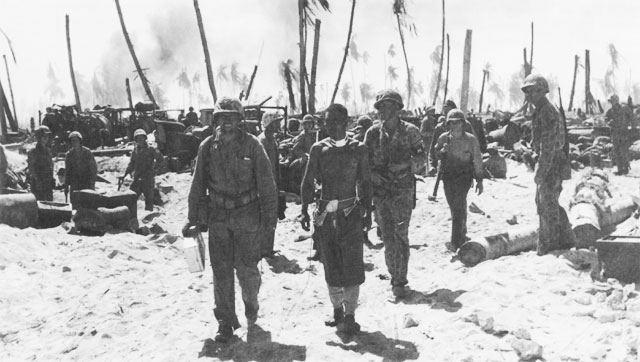“The crowded transports of Task Force 53 arrived off Tarawa Atoll shortly after midnight on D-Day. Debarkation began at 0320. The captain of the Zeilin (APA 3) played the Marines Hymn over the public address system, and the sailors cheered as the 2d Battalion, 2d Marines, crawled over the side and down the cargo nets.
At this point, things started to go wrong. Admiral Hill discovered that the transports were in the wrong anchorage, masking some of the fire support ships, and directed them to shift immediately to the correct site. The landing craft bobbed along in the wake of the ships; some Marines had been halfway down the cargo nets when the ships abruptly weighed anchor. Matching the exact LVTs with their assigned assault teams in the darkness became haphazard. Choppy seas made cross-deck transfers between the small craft dangerous.
Few tactical plans survive the opening rounds of execution, particularly in amphibious operations. “The Plan” for D-Day at Betio established H-Hour for the assault waves at 0830. Strike aircraft from the fast carriers would initiate the action with a half-hour bombing raid at 0545. Then the fire support ships would bombard the island from close range for the ensuing 130 minutes. The planes would return for a final strafing run at H-minus-five, then shift to inland targets as the Marines stormed ashore. None of this went according to plan.
The Japanese initiated the battle. Alerted by the pre-dawn activities offshore, the garrison opened fire on the task force with their big naval guns at 0507. The main batteries of the battleships Colorado (BB 45) and Maryland commenced counterbattery fire almost immediately. Several 16-inch shells found their mark; a huge fireball signalled destruction of an ammunition bunker for one of the Japanese gun positions. Other fire support ships joined in. At 0542 Hill ordered “cease fire,” expecting the air attack to commence momentarily. There was a long silence.
The carrier air group had changed its plans, postponing the strike by 30 minutes. Inexplicably, that unilateral modification was never transmitted to Admiral Hill, the amphibious task force commander. Hill’s problems were further compounded by the sudden loss of communications on his flagship Maryland with the first crashing salvo of the ship’s main battery. The Japanese coastal defense guns were damaged but still dangerous. The American mix-up provided the defenders a grace period of 25 minutes to recover and adjust. Frustrated at every turn, Hill9 ordered his ships to resume firing at 0605. Suddenly, at 0610, the aircraft appeared, bombing and strafing the island for the next few minutes. Amid all this, the sun rose, red and ominous through the thick smoke.” – Across The Reef: The Marine Assault of Tarawa, by Joseph H. Alexander











God bless the United States Marine Corp … Semper Fi brothers.
My grandfather was a Marine photographer at Tarawa. Many of the Photos and footage he took himself. I have seen some of the original footage and photos from that day and they are truly horrifying. They won an academy award because of it what they filmed. You can watch it on Youtube https://www.youtube.com/watch?v=l4q4NZH-eVM